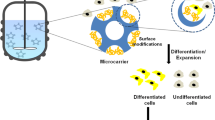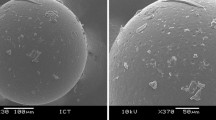Abstract
Polystyrene culture dishes and polystyrene microcarriers were coated with Pronectin-F and poly-l-lysine (polylysine), either alone or in combination. Pronectin-F is a recombinant peptide containing repeats of the RGD cell-attachment sequence from fibronectin. Polylysine is a polymer ofl-lysine. Pronectin-F supported attachment of Madin-Darby Canine Kidney (MDCK) cells at concentrations as low as 0.025 μg/cm2 of surface area. The cells rapidly spread after attachment. Polylysine at concentrations of 0.05–0.5 μg/cm2 also supported cell attachment but cells did not rapidly spread after attachment to this substrate. Higher concentrations of polylysine could not be used because of toxicity. When the two peptides were used in conjunction, MDCK cells attached and spread at lower peptide concentrations than they did when either substrate was used alone. These findings suggest that recombinant Pronectin-F alone or in conjunction with a cationic polymer could be a useful replacement for materials such as gelatin or collagen which are currently used as microcarrier surfaces.
Similar content being viewed by others
References
Fiorentine D, Shahar A and Mizrahi A (1985) Production of herpes virus of turkeys in a microcarrier culturing system —a new method for production of vaccine against Marek's disease. Dev. Biol. Standard 60: 421–430.
Frenette GP, Carey TE, Varani J, Schwartz DR, Fligiel SEG, Ruddon RW and Peters BP (1988) Biosynthesis and secretion of laminin and laminin-associated glycoproteins by nonmalignant and malignant keratinocytes: comparison of cell lines from primary and secondary tumors in the same patient. Cancer Res. 48: 5193–5204.
Giard D (1977) Virus production with a newly developed microcarrier system. Applied. Environ. Microbiol. 34: 668–672.
Ginsburg I (1987) Cationic polyelectrolytes: a new look at their possible roles as opsinins, as stimulators of the respiratory burst in leukocytes, in bacteriolysis and as modulators of immune complex disease. Inflammation 11: 489–515.
Griffiths JB, Thornton B and McEntee I (1982) The development and use of microcarrier and glass sphere culture techniques for the production of herpes simplex virus. Dev. Biol. Standard 50: 103–110.
Hoffman T and Palmer S (1990) Alternative Matrices for the Growth of BHK-21 cells and the production of rubella virus.In Vitro 26: 55A.
Keese C and Giaever I (1983) Cell growth on liquid microcarriers. Science 219: 144–1449.
Larsson B and Litwin J (1987) The growth of polio virus in human diploid fibroblasts grown with cellulose microcarriers in suspension cultures. Dev. Biol. Standard 66: 385–390.
Mered B (1981) Propagation of poliovirus in microcarrier cultures of three monkey kidney cell lines. J. Biol. Standard 9: 137–145.
Nielson V and Johansson I (1980) Biosilon; optimal culture conditions and various research scale culture techniques. Dev. Biol. Standard 46: 131–136.
Obrenovitch A, Maintier C and Sene C (1982) Microcarrier culture of fibroblastic cells on modified trisacryl beads. Biol. Cell 46: 249–256.
Pay TWF (1985) Production of rabies vaccine by an industrial scale BHK 21 suspension cell culture process. Dev. Biol. Standard 60: 171–174.
Plantefaber LC and Hynes RO (1989) Changes in integrin receptors on oncogenically transformed cells. Cell 56: 281–290.
Ruoslahti E and Pierschbacher MD (1986) Arg-Gly-Asp: a versatile cell recognition signal. Cell 44: 517–518.
Schwartz MA (1993) Signaling by integrins: implications for tumorigenesis. Cancer Res. 53: 1503–1506.
Spier RE and Whiteside JP (1976) The production of foot and mouth disease virus from BHK 21 C13 cells grown on the surface of DEAE sephadex A50 beads. Biotech. Bioeng. 28: 659–667.
Scattergood EM (1983) Scale-up of chick cell growth on microcarriers in fermenters for vaccine production. Ann. N. Y. Acad. Sci. 413: 332–339.
van Wezel AL (1967) Growth of cell strains and primary cells on microcarriers. Nature 216: 65–66.
van Wezel AL and van Steenis G (1978) Production of an inactivated rabies vaccine in primary dog kidney cells. Dev. Biol. Standard 40: 69–75.
Varani J, Dame M, Beals TF and Wass JA (1983) Growth of three established cell lines on glass microcarriers. Biotech. Bioeng. 25: 1359–1372.
Varani J, Fligiel SEG, Till GO, Kunkel RG, Ryan US and Ward PA (1985) Pulmonary endothelial cell killing by human neutrophils. Possible involvement of hydroxyl radical. Lab. Invest. 53: 656–663.
Varani J, Fligiel SEG, Inman DR, Helmreich DL, Bendelow MJ and Hillegas W (1989) Substrate-dependent differences in production of extracellular matrix molecules by squamous carcinoma cells and diploid fibroblasts. Biotech. Bioeng. 33: 1235–1241.
Widell A, Hansson BG and Nordenfelt E (1984) A microcarrier cell culture system for large scale production of hepatitis a virus. J. Virolog. Meth. 8: 63–71.
Author information
Authors and Affiliations
Rights and permissions
About this article
Cite this article
Varani, J., Inman, D.R., Fligiel, S.E.G. et al. Use of recombinant and synthetic peptides as attachment factors for cells on microcarriers. Cytotechnology 13, 89–98 (1993). https://doi.org/10.1007/BF00749935
Received:
Accepted:
Issue Date:
DOI: https://doi.org/10.1007/BF00749935




